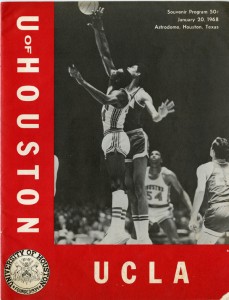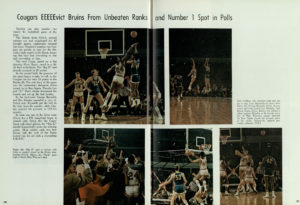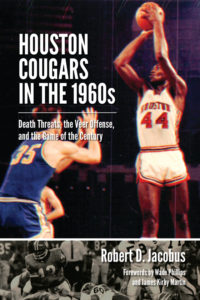
College basketball used to be a small game. A niche sport, once it was played on small courts, in small gymnasiums, in front of small crowds. Just over fifty years ago however, on January 20, 1968 in the Astrodome, the University of Houston (and the University of California, Los Angeles) forever altered the scale of the game in what has become known as the Game of the Century.

program from the Game of the Century (Athletics Department Records)
Regardless of the particulars, it was destined to be a historic match-up. While any given season might feature similar, high-profile, games between highly ranked teams, the 1968 regular season game between UCLA and Houston had a number of compelling story lines that intrigued even the casual sports fan. There was the blue blood, #1 team in the nation (the UCLA Bruins), riding a 47 game winning streak that spanned two and a half years and boasting three of the last four national championships under the tutelage of the legendary “Wizard of Westwood,” John Wooden. Their most recent in 1967 included a 73-58 defeat of the University of Houston Cougars in the Final Four. Anchored by the immeasurable talent of Lew Alcindor (later known as Kareem Abdul-Jabbar), the UCLA Bruins were a legitimate dynasty, ultimately claiming every national championship between 1967 and 1973. In the other corner, the up-and-coming “underdog” program, ranked #2 in the nation and riding their own winning streak (undefeated since their loss to UCLA the previous season), the University of Houston Cougars were coached by Guy V. Lewis, led on the court by the likes of Elvin Hayes, Ken Spain, and Don Chaney, and eager to prove just how good they were after last year’s setback.

a full-color, two page spread from the 1968 Houstonian yearbook documents the Cougars’ victory
Given all of these particulars, how could the game be any bigger? Mix in a grand stage of national television coverage (a first for college basketball) and the surreal setting of the Eighth Wonder of the World.
The court for the contest was shipped in from Los Angeles, ironically enough, and assembled in the Astrodome on top of what should have been second base. It must have looked like a postage stamp to most of the 52,693 fans (a world-wide attendance record for any basketball game) packed into the dark corners of the Dome. Even more watched at home as this “small” game was played against a grand, cavernous backdrop.
TVS Television Network promoted the game and sold broadcasting rights to over 100 television stations across the country. Previously, there had only been efforts to televise games locally and in 1961 a “national” broadcast of the Ohio State / University of Cincinnati game in the NCAA finals was televised in just two cities–Columbus and Cincinnati, Ohio. The pros in the National Basketball Association had only begun the broadcast experiment in the 1950s and were still torn on whether or not they wanted to televise the league’s “good games,” for fear of losing ticket revenue at the turnstile. What was happening now in 1968 was not just novel, it was radical. And, it was successful in more ways than one. Houston defeated UCLA 71-69, ended the Bruins winning streak, and solidified their place in college basketball lore.
In Houston Cougars in the 1960s: Death Threats, the Veer Offense, and the Game of the Century by Robert Jacobus, Houston’s Elvin Hayes reflected back on the legacy of the game saying, “It just created euphoria and an atmosphere for college basketball that wasn’t there previously. I think that game kicked the door down, opened the windows, and knocked the roof off the house. What we have today in March Madness is what I think the game in 1968 opened.”
